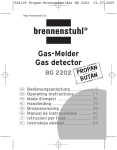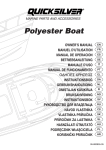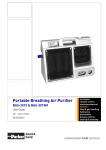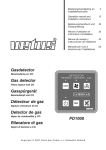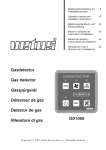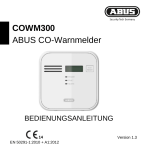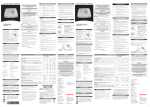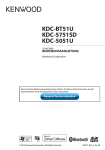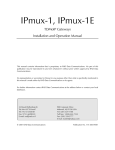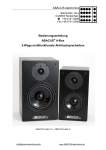Download CO-Alarm - Weinmann & Schanz
Transcript
CO90 CO-Alarm Kohlenmonoxidmelder Bedienungsanleitung und Sicherheitshinweise F GB Mode d'emploi: www.indexa.de > download User manual: www.indexa.de > download Montage- und Bedienungsanleitung mit Sicherheitshinweisen 1 6 7 Einleitung Diese Bedienungsanleitung enthält wichtige Informationen zur sachgerechten Montage sowie zum Betrieb Ihres COAlarms. Bitte lesen Sie diese Anleitung vor der Montage vollständig und sorgfältig durch. Die Bedienungsanleitung gehört zu diesem Produkt und enthält wichtige Hinweise zur Inbetriebnahme und Handhabung. Beachten Sie immer alle Sicherheitshinweise. Sollten Sie Fragen haben oder unsicher in Bezug auf die Handhabung der Geräte sein, dann holen Sie den Rat eines Fachmannes ein. Bewahren Sie die Anleitung auf und geben Sie sie gegebenenfalls an Dritte weiter. CO-ALARM CO 90 2 3 4 ALARM POWER TEST 5 11 EINGANG RELAIS 12 V DC AUSGANG 8 Bestimmungsgemäße Verwendung 9 12-VOLT AUSGANG 10 11 Der CO-Alarm CO90 ist zur Detektion von Kohlenmonoxid konzipiert. Er ist zur Verwendung in Privatwohnungen des Haushalts vorgesehen. Die Auslegung basiert auf Gerätetyp A - um optisch und akustisch zu alarmieren und ein Ausgangssignal auszulösen, das zum direkten oder indirekten Einschalten einer Lüftung oder zur Auslösung einer anderen Hilfseinrichtung, z.B. eine Zusatzsirene, verwendet werden kann. ! Geräte für die Detektion von Kohlenmonoxid sind kein Ersatz für ordnungsgemäße Installation und regelmäßige Wartung von Brennstoff verbrennenden Einrichtungen oder regelmäßige Reinigung und Überprüfung von Kaminen! Dieser Kohlenmonoxidmelder ist nicht als Rauchmelder oder als Detektor für brennbare Gase geeignet! Der CO-Alarm ist in der Normalausführung für den Anschluss an eine Versorgungsspannung von 230 V AC / 50 Hz ausgelegt. Der Anschluss an das Stromnetz erfolgt über eine am Gerät angebrachte Netzleitung. In einer gesonderten Geräteausführung ist der CO-Alarm für eine Betriebsspannung von 12 V DC lieferbar (Art.Nr. 22163). Der elektrische Anschluss erfolgt in diesem Fall über eine 2-polige Anschlussklemme. Der CO-Alarm ist nicht in explosionsgefährdeten Räumen zu verwenden und dient nicht als Maßnahme des primären Explosionsschutzes im Sinne der Richtlinien der Berufsgenossenschaft. Lieferumfang Achtung: ! Dieser Kohlenmonoxidmelder kann unter Umständen Personen, die altersbedingt, aufgrund von Schwangerschaft oder krankheitsbedingt besonders anfällig gegenüber Kohlenmonoxid sind, keinen ausreichenden Schutz bieten. Wenden Sie sich im Zweifelsfall an Ihren Hausarzt. 2 1 Stück 2 Stück 2 Stück 1 Stück CO-Alarm Befestigungsschrauben Befestigungsdübel Bedienungsanleitung und Sicherheitwshinweise Ausstattung (1) (2) (3) (4) (5) (6) (7) (8) Gehäusefrontansicht ALARM LED FEHLER LED POWER LED TEST Taste LC-Display Schallöffnung Signalgeber Klemme EINGANG 12 V DC (nur bei 12 V DC-Ausführung) (9) Klemme RELAIS AUSGANG (10) Klemme 12-VOLT AUSGANG (11) Montagelöcher Technische Daten Alarmschwelle / Empfindlichkeit: Kohlenmonoxid (CO) 50ppm zwischen 60 und 90 Minuten 100ppm zwischen 10 und 40 Minuten 300ppm weniger als 3 Minuten Alarmlautstärke 85 dB (A) / 1 m Relaisausgang potentialfreier Wechselkontakt, 5A/230V AC, 5A/30V DC 12 V DC Ausgang geschaltet bei Alarm, 12 V DC (±10%), max. 200 mA, Reset automatisch, wenn CO-Konzentration unter die Alarmschwelle sinkt Betriebstemperatur -10°C bis +40°C Luftfeuchtigkeit max. 95% rel. Digitalanzeige 3 Ziffern / 7-Segment, Richtwertanzeige Abweichung max. ±20% bei 300ppm CO CE-Konformität EN 61000-6-3:2007 EN 50270:2006 Elektrische Sicherheit EN 60335-1 Abmessungen 140 x 125 x 42 mm (B x H x T) Schutzart IPX2D Schutzklasse II 230 V - Ausführung: Betriebsspannung: 230 V AC / 50 Hz Leistungsaufnahme: max. 6 VA Gewicht: ca. 500 g 12 V - Ausführung: Betriebsspannung: Stromaufnahme: Gewicht: 12 V DC (-15% / +20%) max. 100 mA ca. 250 g Ausführung nach EN 50291:2001 ! Beschädigen Sie bei Bohrarbeiten und beim Befestigen keine Leitungen für Gas, Strom, Wasser oder Telekommunikation! Andernfalls droht Lebens-, Verletzungsgefahr! ! Dieses Gerät ist nur für den Betrieb im Innenbereich geeignet. Von Feuchtigkeit fernhalten. ! Bei Veränderungen am CO-Alarm besteht die mögliche Gefahr eines elektrischen Schlages oder einer Fehlfunktion. ! Wenn die Netzanschlussleitung dieses Gerätes beschädigt wird, muss sie durch den Hersteller oder seinen Kundendienst oder eine ähnlich qualifizierte Person ersetzt werden, um Gefährdungen zu vermeiden. ! Gerät nicht öffnen, dadurch erlischt der Anspruch auf Garantieleistungen. Was ist Kohlenmonoxid? Kohlenmonoxid (CO) ist ein hoch giftiges Gas, das bei der Verbrennung von Brennstoffen freigesetzt wird. Es ist farbund geruchlos und wird daher von den menschlichen Sinnesorganen nur sehr schwer wahrgenommen. Die ersten Warnsymptome für das Vorhandensein von CO in der Luft sind in der Regel Kopfschmerzen und Übelkeit. Eine gefährliche Menge an Kohlenmonoxid kann bei einer unvollständigen Verbrennung von kohlenstoffhaltigem Material, wie zum Beispiel festen Brennstoffen (wie Holz, Kohle, Koks), flüssigen Brennstoffen (wie Öl und Benzin), und gasförmigen Brennstoffen (wie Erdgas, Stadtgas und Flüssiggas (LPG)) entstehen. Dies kann eine oder mehrere der folgenden Ursachen haben: ! Ein Heizgerät ist defekt oder unzureichend gewartet ! Die Lüftung eines Raumes ist nicht ausreichend ! Ein Kamin ist teilweise oder vollständig verstopft oder undicht Symptome: Müdigkeit, Kopfschmerzen, Schwindel, Übelkeit, Schmerzen im Brust- oder Magenbereich Sicherheitshinweise ! Der CO-Alarm darf nur von einer entsprechend qualifizierten Person installiert werden. ! Betreiben Sie den CO-Alarm ausschließlich mit der geräteseitig vorgesehenen Betriebsspannung. ! Lassen Sie Kleinkinder nicht unbeaufsichtigt mit dem Gerät, Verpackungsmaterial oder Kleinteilen! Andernfalls droht Lebensgefahr durch Ersticken! Auswirkungen einer Kohlenmonoxidvergiftung Kohlenmonoxid bindet das Hämoglobin im Blut und reduziert damit den Sauerstofftransport im Körper. Hochkonzentriertes CO führt innerhalb weniger Minuten zum Tod. 35ppm Höchstzulässiger Wert bei andauernder COEinwirkung über einen Zeitraum von 8 Stunden 3 200ppm Leichte Kopfschmerzen, Müdigkeit, Schwindel, Übelkeit nach 2 bis 3 Stunden 400ppm Kopfschmerzen im Stirnbereich innerhalb von 1 bis 2 Stunden, Lebensgefahr nach 3 Stunden 800ppm Schwindelgefühl, Übelkeit und Schüttelkrämpfe innerhalb von 45 Minuten, Bewusstlosigkeit innerhalb von 2 Stunden, Tod innerhalb von 2 bis 3 Stunden 1600ppm Kopfschmerzen, Schwindelgefühl und Übelkeit innerhalb von 20 Minuten, Tod innerhalb von 1 Stunde 6400ppm Kopfschmerzen, Schwindelgefühl und Übelkeit innerhalb von 1 bis 2 Minuten, Tod innerhalb von 10 bis 15 Minuten Hinweis: Anzeige zeigt bis max. 999ppm! Räume, in denen ein Kohlenmonoxidmelder anzubringen ist Idealerweise sollte ein Kohlenmonoxidmelder in jedem Raum installiert werden, der eine Verbrennungseinrichtung enthält. Sind jedoch Verbrennungseinrichtungen in mehr als einem Raum vorhanden und steht Ihnen lediglich eine begrenzte Anzahl oder nur ein Melder zur Verfügung, sollten bei der Suche nach dem besten Standort folgende Punkte beachtet werden: ! Wenn sich in einem Raum, in dem Sie schlafen, ein Brennstoffgerät befindet, sollten Sie einen Melder in diesem Raum anbringen. ! Wenn sich in dem Raum, in dem Sie einen Großteil Ihrer Zeit verbringen, z.B. dem Wohnzimmer, ein Brennstoffgerät befindet, sollten Sie einen Melder in diesem Raum anbringen. ! In einem 1-Zimmer-Appartement sollte das Gerät so weit wie möglich von der Kochgelegenheit entfernt, aber nahe zur Schlafstelle angebracht werden. ! Wenn sich eine Verbrennungseinrichtung in einem normalerweise nicht benutzten Raum befindet (z.B. einem Boilerraum), bringen Sie einen Kohlenmonoxidmelder direkt außerhalb dieses Raums an, sodass der Alarm leichter gehört werden kann. Alternativ kann eine externe Alarmsirene mit dem Schaltausgang am Gerät verbunden werden. 4 Platzierung Der CO-Alarm ist bestimmungsgemäß für die Wandmontage vorgesehen. Der Montageort ist nach folgenden Kriterien zu wählen: CO-Alarm im gleichen Raum wie eine Verbrennungseinrichtung: ! Das Gerät sollte nahe zur Decke, jedoch mindestens 150 mm von der Decke entfernt angebracht werden. ! Das Gerät sollte sich in einer Höhe oberhalb aller Türen oder Fenster befinden. ! Der Kohlenmonoxidmelder sollte einen waagrechten Abstand zwischen 1 m bis 3 m von der möglichen Quelle haben. ! Wenn es eine Unterteilung in einem Zimmer gibt, sollte der Detektor sich auf derselben Seite der Unterteilung wie die mögliche Quelle befinden. ! In Räumen mit schrägen Decken sollte der CO-Alarm auf der höheren Seite des Raumes angebracht werden. CO-Alarm in Schlafzimmern und in Räumen, die entfernt von einer Verbrennungseinrichtung liegen: ! Die Kohlenmonoxidmelder sollten sich in Atemhöhe der Bewohner befinden. Folgende Stellen sind als Montageort NICHT geeignet: ! Außerhalb von Gebäuden, z.B. zur Überwachung von offenen Flaschenkästen ! Abgetrennte Bereiche (z.B. Schrankinnenräume oder Bereich hinter Gardinen), die im Falle eines Gasaustritts die Alarmauslösung blockieren könnten ! Neben einer Tür oder einem Fenster ! Im Luftstrom von Ventilatoren (Belüftung, Klimaanlage etc.) ! Nahe einem Luftabzug (z.B. Dunstabzugshaube) oder anderen ähnlichen Lüftungsöffnungen ! Bereiche, in denen die Temperatur unter -10° C fallen oder über +40° C steigen kann ! Feuchträume wie Badezimmer und Duschen, in denen die relative Luftfeuchtigkeit auf über 95 % ansteigen kann ! Unmittelbar neben einem Kochherd ! Direkt oberhalb von Kochstellen ! Direkt oberhalb eines Abflusses oder eines Waschbeckens ! Bereiche, wo Schmutz und Staub den Sensor verstopfen können ! In explosionsgefährdeten Räumen ! In Garagen, sowie an anderen Stellen wo Kohlenmonoxid präsent ist. Für die Überwachung von Tiefgaragen eine Anlage nach VDI 2053 und den örtlichen Garagenverordung verwenden Das Gerät darf nicht im Freien betrieben werden! Montage Stellen Sie sicher, dass während der Montage und beim Anschluss der Stromversorgung keine Spannung anliegt! Das Gerät wird mit zwei Schrauben an der Wand bzw. dem gewünschten Montageort befestigt. Verwenden Sie hierzu beiliegende Schrauben. Die Montagelöcher sowie auch die Anschlussklemmen liegen unter einer Abdeckplatte. Diese Abdeckung ist lediglich mit zwei Zapfen aufgesteckt und kann ohne weitere Hilfsmittel durch seitliches Eingreifen abgehoben werden. Unbedingt Montagehöhe nach Kapitel "Platzierung" beachten! Elektrischer Anschluss 230 V - Ausführung: Der CO-Alarm wird mit Anschlusskabel und Eurostecker geliefert. Dafür ist eine Eurosteckdose mit 230 V AC (Wechselstrom) zu verwenden. 12 V - Ausführung: Elektrischer Anschluss nur an 12 Volt Gleichspannung (DC). Toleranz: -15% / +20% Zum Anschluss empfehlen wir eine Leitung mit Aderkennzeichnung. Schließen Sie das Versorgungskabel an die mit '+' und ' - ' bezeichneten Anschlussklemmen an. Stellen Sie hierbei sicher, dass während des Anschlusses der Stromversorgung keine Spannung anliegt. Auf polrichtigen Anschluss achten! Schaltausgänge Der CO-Alarm verfügt über zwei Schaltausgänge zur Ansteuerung einer Alarmanlage oder weiterer Signalgeber und Geräte. Die jeweiligen Anschlussklemmen befinden sich unter der Abdeckplatte. Der Anschluss muss immer bei unterbrochener Stromzufuhr erfolgen! 12-Volt Schaltausgang Geschaltetes 12 V DC Signal zur direkten Ansteuerung von z.B. einer externen Hupe (z.B. AS05, Art.Nr. 33133) oder Warnlampe (z.B. BL01, Art.Nr. 33134). Die Maximallast beträgt 200 mA. Der Anschluss erfolgt über die 2-polige Anschlussklemme +/- Ausgang. Auf polrichtigen Anschluss achten! Relaisausgang Potentialfreier Schließer- und Öffnerkontakt. Diese Kontakte werden zum Anschluss an eine Alarmanlage, ein Telefonwählgerät, eine Warnleuchte o.ä. verwendet. Die Verbindung für einen Schließerkontakt (normalerweise offen ® schließt bei Alarm) erfolgt an den Klemmen N.O. und COM. Die Verbindung für einen Öffnerkontakt (normalerweise geschlossen ® öffnet bei Alarm) erfolgt an den Klemmen N.C. und COM. Im spannungslosen Zustand des CO-Alarms sowie im Normalbetrieb sind die Kontakte N.C. und COM geschlossen, d.h. das Relais befindet sich im Ruhezustand. Bei Benutzung des Relaisausgangs mit Spannungen von mehr als 25 V olt AC oder 25 Volt DC muss bauseits eine Klemmendose zum Anschluss des Kabels zum externen Verbraucher (z.B. Warnleuchte) gesetzt werden. Die Installation muss von einer Elektrofachkraft durchgeführt werden. Inbetriebnahme Sobald der CO-Alarm fehlerfrei an die Stromversorgung angeschlossen ist, findet ein automatischer Selbsttest statt: Die grüne POWER LED blinkt für eine Dauer von max. 90 Sekunden. Anschließend leuchten im Wechsel die grüne, die gelbe und die rote LED auf. Im Display werden drei Querbalken angezeigt. Dies dauert ca. 50 Sekunden. Nach erfolgreichem Selbsttest ertönt kurz die Signalhupe. Anschließend zeigt die grüne POWER-LED die Betriebsbereitschaft an. Ausnahmefall: Herrscht bei der Inbetriebnahme bereits eine CO-Alarmkonzentration vor, so blinkt die grüne POWER-LED für eine Dauer von 90 Sekunden. Daran anschließend wechselt das System in die Betriebsfunktion und die vorherrschende COKonzentration wird 15 Sekunden lang im Display angezeigt. Die Alarmmeldung erfolgt gemäß der im Kapitel "Technische Daten" in Abhängigkeit der CO-Konzentration genannten Verzögerungszeit. 5 Betriebsfunktionen Normalbetrieb Die grüne POWER-Anzeige leuchtet dauerhaft. Der CO-Alarm ist betriebsbereit. Alarm Überschreitet die Kohlenmonoxidkonzentration am Sensor die werkseitig voreingestellte Empfindlichkeitsschwelle, gibt das Gerät Alarm: Es wird eine sich wiederholende Sequenz von 4 Signaltönen mit gleichzeitigem Aufleuchten der ALARM -Leuchte ausgegeben. wiederholende Sequenz von 4 Signaltönen gleichzeitig rote ALARM-Leuchte Ein Signal wird an ggf. weitere angeschlossene Geräte weitergegeben. Der Alarm erfolgt so lange, bis die Kohlenmonoxidkonzentration wieder unter die voreingestellte Empfindlichkeitsschwelle sinkt. Im Alarmfall den CO-Alarm nicht ausstecken! Stummschaltfunktion Bei Bedarf kann im Alarmzustand der akustische Alarm durch Drücken der TEST-Taste für eine Dauer von 5 Minuten ausgestellt werden. Die rote ALARM-Leuchte blinkt weiterhin. Wenn nach Ablauf der 5-minütigen Stummphase nach wie vor Kohlenmonoxid vorhanden ist, ertönt wieder der akustische Alarm. Hinweis: ! Die Stummschaltfunktion kann bei einer Kohlenmonoxidkonzentration von über 350 ppm nicht aktiviert werden. ! Die Stummschaltfunktion ist während einer ALARMPhase nur einmalig möglich, d.h. der akustische Alarm kann nur einmal für 5 Minuten unterdrückt werden. Rückkehr zum Normalbetrieb Wenn die Kohlenmonoxidkonzentration wieder unter die voreingestellte Empfindlichkeitsschwelle sinkt, erlischt der Alarm. Die grüne POWER-Anzeige leuchtet dauerhaft. Fehleranzeige Der CO-Alarm führt eine ständige Selbstkontrolle durch. Hierbei auftretende Fehler werden durch Blinken der gelben FEHLER-Anzeige angezeigt. Weiterhin werden zwei kurze Signaltöne pro Minute ausgegeben. 2 kurze Signaltöne alle 60 Sekunden, gelbe FEHLER-Anzeige blinkt 6 Wird die FEHLER-Anzeige aktiv, so liegt entweder ein Gerätedefekt vor oder der CO-Alarm ist nach einer Betriebsdauer von ca. 6 Jahren verbraucht. In diesem Fall ist der CO-Alarm zu ersetzen! Digitales Display Zur Anzeige der CO-Konzentration ist der CO-Alarm mit einem digitalen Display (LCD) ausgestattet. Die angezeigte Einheit ist Parts Per Million (ppm). Die LCD kann Werte zwischen 30 und 999 ppm anzeigen. Normalbetrieb Bei normaler Umgebungsluft werden keine Werte angezeigt. LCD, Kundenaktivierung Die Aktivierung erfolgt durch Drücken der TEST-Taste für eine Dauer von 1-2 Sekunden: ! Ist die gemessene CO-Konzentration kleiner als 30 ppm, so erscheint folgende Anzeige: - - ! Ist die Konzentration größer als 30 ppm, so wird der gemessene CO-Wert angezeigt. Die Anzeige bleibt für eine Dauer von 15 Sekunden aktiv. LCD, Automatische Aktivierung Steigt die CO-Konzentration auf einen Wert von über 50 ppm und geht der CO-Alarml in den ALARM-Status, so wird die digitale Anzeige automatisch aktiviert. Die Anzeige bleibt solange aktiv, wie der Alarm ansteht. Verhalten bei einem Alarm Bewahren Sie im Falle eines Alarms Ruhe. Führen Sie folgende Maßnahmen durch: ! Öffnen Sie alle Türen und Fenster, damit der Bereich stärker belüftet wird und das Kohlenmonoxid sich verflüchtigen kann. ! Beenden Sie die Verwendung aller Verbrennungseinrichtungen und stellen Sie sicher, falls möglich, dass sie ausgeschaltet sind. ! Wenn der Alarm weiterhin anhält, dann räumen Sie das Gebäude. Lassen Sie Türen und Fenster geöffnet. ! Betreten Sie das Gebäude erst wieder, wenn das Alarmsignal verstummt ist. ! Besorgen Sie medizinische Hilfe für alle, die an den Wirkungen einer Kohlenmonoxidvergiftung leiden. Weisen Sie darauf hin, dass der Verdacht auf eine Kohlenmonoxidvergiftung besteht. ! Rufen Sie Ihre Wartungs- oder Instandhaltungsfirma der Einrichtung an oder Ihren Gas- bzw. Brennstofflieferanten. Erläutern Sie das Problem. ! Nehmen Sie die Brennstoff verbrennenden Einrichtungen erst wieder in Betrieb, nachdem sie durch eine sachkundige Person entsprechend den nationalen Bestimmungen überprüft und für die Benutzung freigegeben worden sind. ! Der CO-Alarm liefert ein Ausgangssignal, das verwendet werden kann, um eine Hilfsvorrichtung wie einen Lüftungsventilator oder ein Gasabsperrventil auszulösen. Einmal ausgelöst müssen diese Vorrichtungen möglicherweise manuell zurückgestellt werden. Diese Rückstellung sollte erst durchgeführt werden, nachdem die Quelle des Kohlenmonoxids identifiziert und der Fehler beseitigt worden ist. Im Falle von gasbetriebenen Geräten darf die Entriegelung zur erneuten Gaszufuhr nach einem Schließen des Magnetventils nur durch einen Fachmann des Vertragsinstallations- oder Gasversorgungsunternehmens vorgenommen werden. Funktionsprüfung Der CO-Alarm ist einmal monatlich auf ordnungsgemäße Funktion zu überprüfen. Bitte halten Sie hierzu die TEST-Taste 4 Sekunden lang gedrückt. Dadurch wird die Funktionsprüfung aktiviert. Während der Funktionsprüfung werden die drei Leuchtanzeigen im laufenden Wechsel aktiviert. Im Display werden drei Querbalken angezeigt. Nach Abschluss des Funktionstests ertönt die Signalhupe für eine Dauer von 2 Sekunden. Wenn der CO-Alarm einwandfrei funktioniert, leuchtet die grüne Anzeige anschließend wieder permanent. Bei der Funktionsprüfung wird der Sensor und die interne Elektronik getestet, die Relais- und 12 V - Ausgänge werden nicht aktiviert. Führen Sie die Funktionsprüfung in regelmäßigen Abständen, mindestens alle 4 Wochen, durch! Ausnahmefälle: ! Im Alarmfall kann kein Funktionstest durchgeführt werden. ! Herrscht eine CO-Alarmkonzentration - jedoch noch kein ausgelöster Alarm - vor, so wird beim Drücken der TESTTaste die aktuelle CO-Konzentration für eine Dauer von 15 Sekunden angezeigt. Ein Funktionstest wird in diesem Fall nicht gestartet. Fehlalarm Der CO-Alarm ist seinem Zweck entsprechend sehr empfindlich eingestellt. Der Sensor des Systems kann deshalb auch auf andere gasförmige Medien ansprechen. Der Gebrauch von Aerosolen (Treibgas in Sprays usw.) sowie eine hohe Konzentration an Tabakrauch kann einen Alarm auslösen. Ebenso kann das Gerät auf kurze Abgasabgaben, z.B. während des Anspringens einer Einrichtung, reagieren. Wartung und Reinigung ! Reinigen Sie regelmäßig das Gehäuse des CO-Alarm mit einem Staublappen oder einem leicht feuchten Tuch. Entfernen Sie hierbei mögliche Staubablagerungen an den Gehäuseöffnungsschlitzen. Verwenden Sie auf keinen Fall Haushaltsreiniger mit Ammoniak (Salmiakgeist) oder andere Chemikalien wie Reinigungsmittel oder Lösungsmittel. Der CO-Alarm darf niemals mit Wasser besprüht werden! ! Der CO-Alarm darf nicht gestrichen oder lackiert werden. ! Kontrollieren Sie regelmäßig die Funktionstüchtigkeit des Gerätes (siehe Kap. Funktionsprüfung). Ende der Lebensdauer des Melders Bei normalem Gebrauch beträgt die Lebensdauer des Melders bis zu 6 Jahre. Ersetzen Sie den CO-Alarm 6 Jahre nach Kaufdatum oder wenn das Fehlerwarnsignal ausgegeben wird. Wichtige Hinweise ! Es wird darauf hingewiesen, dass die Gasinstallation und gegebenenfalls die Abschaltvorrichtung die gültigen nationalen Vorschriften des Landes, in dem sie installiert wird, erfüllen muss. ! Der CO-Alarm ist fachgerecht zu installieren. Bitte befolgen Sie diese Bedienungsanleitung. ! Beachten Sie unbedingt die Montagehöhe des COAlarms. ! Um technisch stets aktuelle Warngeräte anbieten zu können, behalten wir uns Verbesserungen von Konstruktion und Design vor. 7 Entsorgung Sie dürfen Verpackungsmaterial oder Geräte nicht im Hausmüll entsorgen, führen Sie sie der Wiederverwertung zu. Den zuständigen Recyclinghof bzw. die nächste Sammelstelle erfragen Sie bei Ihrer Gemeinde. Garantie Wir gewähren auf dieses Gerät 2 Jahre Garantie ab Kaufdatum. Die Garantieleistung gilt ausschließlich für Material- und Fabrikationsfehler. Es besteht kein Anspruch auf Schadensersatz im Falle eines Brandes, einer Explosion oder einer CO-Vergiftung/Tod. Wir sind nicht verpflichtet, eine Reparatur oder einen Austausch von Teilen zu übernehmen, deren Mängel auf missbräuchliche Verwendung, Beschädigung oder Umbau nach dem Kaufdatum zurückzuführen sind. Die sich aus dem Verkauf des CO-Alarms für uns ergebende Haftungsverpflichtung überschreitet keinesfalls die Kosten für den Produktaustausch. Wir haften keinesfalls für Folgeschäden, die sich aus dem Produktmangel ergeben. Soweit eine Haftung nicht zwingend gesetzlich vorgeschrieben ist, sind weitergehende oder andere Ansprüche, insbesondere solche auf Ersatz außerhalb des Gerätes entstehender Personen- oder Sachschäden durch keine oder fehlerhafte Funktion ausgeschlossen. Die Garantie gilt in Verbindung mit dem Kaufbeleg, der mit dem Gerät einzusenden ist. Die Rücksendung hat frei Haus zu erfolgen. Bei Eingriffen in das Gerät entfällt der Garantieanspruch. Ihre gesetzlichen Rechte werden durch diese Garantie nicht eingeschränkt. Das Produkt ist ausschließlich für den privaten und nicht für den gewerblichen Gebrauch bestimmt. Indexa GmbH Paul-Böhringer-Str. 3 74229 Oedheim Deutschland www.indexa.de 2012-04-02 8 CO 90 GB CO-Alarm with carbon monoxide sensor Operating Instructions F CO-Alarm avec capteur pour le monoxyde de carbone Mode d'emploi page Installation and Operating Instructions GB Introduction These operating instructions provide important information on the correct installation and operation of the gas alarm. Please read the instructions completely and carefully before installation. The operating instructions belong to this product and contain important points concerning bringing the appliance into service and its operation. Always pay attention to all safety instructions. Should you have any questions or be unsure about operating the appliance ask a specialist. Keep the instructions and pass them on to third parties as necessary. Intended use The CO 90 is designed to detect carbon monoxide. It is intended for use in private homes. The design is based on a type A device - to emit a visual and acoustic alarm and trigger an output signal which, in turn, directly or indirectly activates the ventilation or triggers other auxiliary equipment. The CO alarm is designed to be connected to a supply voltage of 230 V AC / 50 Hz. A mains cable attached to the device is used to connect to the mains. As a separate model, the CO alarm is available for an operating voltage of 12 V DC. The electrical connection for this model is made via a 2-pole connecting terminal. The CO alarm must not be used in rooms with potentially explosive atmospheres and is not a primary measure of protection against explosions in accordance with the guidelines of the Accident Prevention & Insurance Association. Attention: ! Under certain circumstances, this carbon monoxide alarm may not provide adequate protection to persons who because of their age, because of pregnancy, or because of illness are especially susceptible to the effects of carbon monoxide. If in doubt, ask your GP. ! Devices designed to detect carbon monoxide are not a substitute for the correct installation and regular maintenance of fuel-fired equipment or regular chimney cleaning and maintainance thereof! This carbon monoxide alarm is not suitable for use as a smoke alarm or as a de a detector of combustible gases! Scope of delivery 1 2 2 1 CO 90 fixing screws used for installation fixing plugs Installation and Operating Instructions Technical data Alarm threshold / sensitivity: Carbon monoxide (CO) 50 ppm between 60 and 90 minutes 100 ppm between 10 and 40 minutes 300 ppm less than 3 minutes Alarm volume 85 dB (A) / 1 m Relay output potential-free changeover contact, 5A/230V AC, 5A/30V DC 12 V DC output switched when an alarm goes off, 12 V DC (±10%), max. 200 mA Reset automatic if CO concentrations fall below the alarm threshold Operating temperature -10°C to +40°C Humidity max. 95% rel. Digital display 3 digits/7 segments, reference value display Deviation max. ±20% at 300 ppm CO CE conformity EN 61000-6-3:2007 EN 50270:2006 Electrical safety EN 60335-1 Dimensions 140 x 125 x 42 mm (W x H x D) Protection level IPX2D Protection class II 230 V model: Operating voltage: Power consumption: Weight: 230 V AC / 50 Hz max. 6 VA approx. 500 g 12 V model: Operating voltage: Current consumption: Weight: 12 V DC (-15% / +20%) max. 100 mA approx. 250 g Safety information ! The carbon monoxide alarm may only be installed by a person who is properly qualified. ! Only operate the CO alarm with the operating voltage specified for the device. ! Do not leave small children unsupervised with the appliance, batteries, packing material or small parts. Otherwise there is a risk of fatal injury due to choking. ! Do not damage any cables or pipes for gas, electricity, water or telecoms when you are drilling or mounting the device! Otherwise there is a risk to life and limb! ! This device is only suitable for indoor use. Keep away from moisture. ! Modifications made to the CO alarm can result in electric shock or malfunction. ! If the mains power cable of this device is damaged, it must be replaced by the manufacturer or his customer service department or a similarly qualified person in order to avoid hazards. ! Do not open the device. Opening the device voids all guarantee claims. What is carbon monoxide? Carbon monoxide (CO) is a highly toxic gas released when fuels are burned. It is colourless and odourless and is, therefore, very difficult for human senses to perceive. The first warning symptoms of the presence of CO in the air are usually headaches and nausea. A dangerous amount of carbon monoxide can result from the incomplete burning of carbon-based materials, e.g. solid fuels (such as wood, coal, coke), liquid fuels (such as oil and benzene) and gas fuels (such as natural gas, town gas and liquefied petroleum gas (LPG)). This can have one or more of the following causes: ! The heating device is defective or has been inadequately maintained ! The ventilation of the room is inadequate ! A chimney or flue is partly or completely blocked or leaking Symptoms: Fatigue, headaches, dizziness, nausea, general pains in the chest or stomach area Effects of carbon monoxide poisoning Carbon monoxide binds the haemoglobin in the blood which reduces the oxygen transported in the body. Highly concentrated CO leads to death within minutes. 35 ppm 200 ppm 400 ppm 800 ppm 1600 ppm 6400 ppm The highest permissible CO value over a period of 8 hours Light headache, fatigue, dizziness, nausea after 2 to 3 hours Headache in the area of the forehead within 1 to 2 hours, risk of death after 3 hours Dizziness, nausea and convulsions within 45 minutes, loss of consciousness within 2 hours, death within 2 to 3 hours Headaches, dizziness and nausea within 20 minutes, death within 1 hour Headaches, dizziness and nausea within 1 to 2 minutes, death within 10 to 15 minutes Rooms in which a carbon monoxide alarm must be installed Ideally, a carbon monoxide alarm should be installed in every room with a combustion device or where a flue/chimney passes through. If there are combustion devices in more than one room, however, and there are only a limited number of alarms or just one alarm available, the following points should be taken into account in the selection of the best location: ! If there is a combustion device in a room in which you sleep, you should install an alarm in this room. ! If there is a combustion device in the room in which you spend a lot of your time, e.g. the living room, you should install an alarm in this room. ! In a 1-room apartment, the alarm should be installed as far away as possible from the cooking facilities but close to the sleeping area. ! If there is a combustion device in a room which is normally not used (e.g. boiler room), you should install a carbon monoxide alarm directly outside this room so that the alarm can be heard more easily. Alternatively, an external alarm siren can be connected to the alarm's switching output. Placement The CO alarm is designed to be wall-mounted. The installation location must be selected in accordance with the following criteria: When the CO alarm is installed in the room where there is a combustion device: ! The alarm should be installed close to the ceiling but no closer than 150 mm from the ceiling. ! The alarm should be placed at a height above that of all doors and windows. ! The carbon monoxide alarm should be placed at a distance which, measured horizontally, is between 1 m and 3 m from the possible source. ! If there is a partition in a room, the detector should be on the same side of the partition as the possible source. ! In rooms with slanted ceilings, the CO alarm should be installed on the higher side of the room. When the CO alarm is installed in bedrooms and in rooms which are far away from a combustion device: ! The carbon monoxide alarm should be installed at a height of 1.5 m above floor level. The following locations are not suitable installation sites: ! Outside of buildings, e.g. for the monitoring of open gas-bottle crates ! Separated areas (e.g. closet interiors or behind curtains) which could, in the event of a gas leak, prevent the alarm from triggering ! Next to a door or window ! In air currents from fans (ventilation, airconditioning, etc.) ! Close to an air vent (e.g. extraction hood) or other similar equipment Ventilation openings ! Areas in which the temperature can fall below 10° C or rise above +40° C ! Damp or wet rooms such as bathrooms and showers where the relative humidity can rise above 95% ! Directly next to a cooking stove ! Directly above cooking facilities ! Directly above a drain or a basin ! Areas where dirt and dust can clog the sensor ! In rooms with potentially explosive atmospheres The alarm must not be used outdoors! Installation Make sure that the voltage is disconnected during installation and when connecting the power supply! Two screws are used to fasten the alarm to the wall or selected location. Use the enclosed screws. Both the assembly holes and the connection terminals are under a cover plate. The cover plate is attached simply with two pins and can be lifted off carefully without the need for tools. Make absolutely sure to install the alarm at the height specified in the chapter entitled 'Placement'! Electrical connection 230 V model: The CO alarm is delivered with a connection cable and Euro plug. This is to be used with a 230 V AC (alternating current) power socket. 12 V model: Electrical connection to 12 Volt direct current (DC) only. Tolerance: -15% / +20% We recommend a connection cable with core identification. Connect the supply cable to the '+' and '-' connection terminals. Make sure that the voltage is disconnected when connecting the current supply. Make sure the connections have the correct polarity! Switching outputs The CO alarm has two switching outputs which are used to control an alarm system or other signal transmitters and devices. The respective connection terminals are under the cover plate. Only connect the alarm when the power supply is disconnected! 12 Volt switching output Switched 12 V DC signal for the direct control of an external horn (AS 05, Art.Nr. 33 133) or warning light (BL 01, Art.Nr. 33 134), for example. The maximum load is 200 mA. The connection is made via a 2-pole +/- terminal output connection. Make sure the connections have the correct polarity! Relay output Potential-free NO and NC contact. These contacts are used for connection to an alarm system, a telephone dialer, a warning light or similar. Connection to an NO contact (normally open ® closes in the event of an alarm) is made at the N.O. and COM terminals. Connection to an NC contact (normally closed ® opens in the event of an alarm) is made at the N.C. and COM terminals. When the CO alarm is not powered and in normal mode, the N.C. and COM contacts are closed, i.e. the relay is at rest. sensitivity threshold set in the factory: A repeating sequence of 4 signal tones with simultaneous illumination of the ALARM light is output. When using the relay output with voltages higher than 25 Volt AC or 25 V olt DC, a terminal box on site must be used for connection of the cable to the external consumer (e.g. warning light). Installation must be carried out by a qualified electrician. Commissioning As soon as the CO alarm has been properly connected to the current supply, an automatic self-test is conducted: The green POWER LED flashes for up to 90 seconds. The green, yellow and red LEDs then flash alternately. Three dashes will appear on the display. This takes approx. 50 seconds. A signal horn sounds when the self-test has been successfully completed. The green POWER LED then indicates that the alarm is operational. Exception: The green POWER LED will flash for 90 seconds if, during commissioning, there is already a CO concentration sufficient to trigger an alarm. The system then switches into operating mode and the prevailing CO concentration shows on the display for 15 seconds. Depending on the CO concentration, the alarm signal triggers with the time delay specified in the chapter entitled 'Technical specifications'. Operating functions Normal mode The green POWER indicator lights continuously. The CO alarm is operational. Alarm The device emits an alarm if the sensor registers a carbon monoxide concentration in excess of the Repeating sequence of 4 signal tones Simultaneous red ALARM light A signal is passed/given to any other connected devices. The alarm continues until the carbon monoxide concentration falls below the preset sensitivity threshold. Do not disconnect the CO alarm in the event of an alarm! Mute function If necessary, the acoustic alarm during the alarm status can be turned off for 5 minutes by pressing the TEST button. The red ALARM light will continue to flash. The acoustic alarm will sound again if carbon monoxide is still present after the 5-minute mute phase. Note: ! The mute function cannot be activated if the carbon monoxide concentration exceeds 350 ppm. ! The mute function can only be used once during an ALARM phase, i.e. the acoustic alarm can only be suppressed once for a period of 5 minutes. Returning to normal mode The alarm ends if the carbon monoxide concentration falls below the preset sensitivity threshold. The green POWER indicator lights continuously. Fault display The CO alarm carries out a continuous self-test. Flashing of the yellow FAULT indictor indicates the presence of a fault. In addition, two short signal tones are issued per minute. 2 short signal tones every 60 seconds, yellow FAULT indicator flashes If the FAULT indicator is active, there is contamination in the device or the CO alarm has reached the end of it's service life of approx. 6 years. The CO alarm must be replaced! Digital display The carbon monoxide alarm is equipped with a digital display (LCD display) to show the CO concentration. The unit shown on the display is parts per million (ppm). The LCD display can show values between 30 and 999 ppm. Normal mode No values are shown if the ambient air is normal. Activation of the LCD by the customer Press the TEST button for 1-2 seconds to activate the LCD: ! The following display appears if the measured CO concentration is less than 30 ppm: - - ! The measured CO value is displayed if the concentration is greater than 30 ppm. The display remains active for 15 seconds. Automatic activation of the LCD If the CO concentration rises to a value of more than 50 ppm and the carbon monoxide alarm goes into ALARM status, the digital display will automatically activate. The display remains active for as long as the alarm continues. What to do in the event of an alarm Remain calm in the event of an alarm. Carry out the following measures: ! Open all doors and windows to increase ventilation and allow the carbon monoxide to escape. ! Stop using all combustion devices and, if possible, make sure they are switched off. ! If the alarm continues, clear the building. Leave doors and windows open. ! Do not enter the building again until the alarm signal has muted. ! Get medical assistance for anyone who shows symptoms of carbon monoxide poisoning. Draw attention to the fact that carbon monoxide poisoning is suspected. ! Call the maintenance or service company for the equipment or your gas or fuel supplier. Explain the problem. ! Do not use the combustion equipment again until a person with the required qualification has inspected the equipment in accordance with applicable requirements and has approved the equipment for use. ! The CO alarm issues an output signal which can be used to trigger auxiliary equipment such as a ventilation fan or a gas shutoff valve. Once it has been triggered, it may be necessary to manually reset the equipment. The equipment should not be reset until the source of the carbon monoxide has been identified and the fault has been corrected. In the case of gas-operated devices, if the gas supply was cut off by closing the solenoid valve, it may only be opened by a qualified plumbing contractor or a specialist from the gas supplier. Function checks Test the alarm once a month to ensure it is functioning correctly. To do this, keep the TEST button pressed for 4 seconds. This activates the function test. The three LED light indicators are activated alternately during the function test. Three dashes appear on the display. The signal horn sounds for 2 seconds at the end of the function test. If the carbon monoxide alarm is functioning properly, the green indicator lights up again permanently. The function test should be carried out regularly, at least every 4 weeks! Exceptions: ! A function test cannot be carried out during an alarm. ! If there is a CO concentration sufficient to trigger an alarm - but an alarm has not been triggered yet the current CO concentration is displayed for 15 seconds when the TEST button is pressed. In this case, a function test is not started. False alarm To fulfil its purpose, the carbon monoxide alarm is set so that it is very sensitive. The system's sensor can therefore also respond to other gaseous media. The use of aerosols (propellants in sprays, etc.) and high tobacco smoke concentrations can also trigger an alarm. The device can also react to brief emissions of exhaust gas, for example, when the equipment starts. Maintenance and cleaning ! Regularly clean the housing of the carbon monoxide alarm with a duster or slightly damp cloth. Remove as much of the dust deposits as possible from the slit openings in the housing. Never use household cleaners with ammonia (spirits of ammonia) or other chemicals, such as cleaning agents or solvents. The CO alarm must never be sprayed with water! ! The carbon monoxide alarm must not be painted or coated. ! Regularly check the functionality of the device (see the chapter on function tests). At the end of the alarm's service life Under normal use, the alarm has a service life of up to 6 years. Replace the carbon monoxide alarm 6 years after the date of purchase or if the fault warning signal is emitted. Important ! Any gas installation and any shut-off device must fulfil the regulations that apply in the country where the alarm is installed. ! The CO alarm must be installed properly. Please work as specified in the operating instructions. ! Make absolutely sure that the CO alarm is installed at the correct height. ! We reserve the right to make improvements to the construction and design. Disposal Packaging material, used batteries or electrical products must not be disposed of as household waste. Use your recycling system. Details are available from your local authority. Guarantee We guarantee this device for 2 years from the date of purchase. The guarantee applies only to material and manufacturing defects. Further claims or other claims, especially those for compensation for injury to persons or damage to property outside of the device, are excluded. There is no legal claim for the compensation of damage injury or death arising from co-poisoning, fire or explosion. We are under no obligation to make repairs or to replace components whose defects derive from misuse, damage or modification after the date of purchase. The liability arising from the sale of the CO alarm will under no circumstances exceed the cost for replacement of the product. Under no circumstances will we assume liability for consequential damages arising from product defects. Further claims, especially claims for damages that occur to persons or things other than the product are excluded, as long as no liability is ordered by law. The guarantee applies in connection with the sales receipt which must be sent in with the device. The cost of postage is borne by the customer. Unauthorised work on the device invalidates all guarantee claims. Your statutory rights are not limited by this guarantee. The product is intended for private use only, and not for commercial use. Indexa GmbH Paul-Böhringer-Str. 3 D-74229 Oedheim CO 90 2011-01-28_GB Directives de montage et Mode d'emploi F Introduction Ce mode d'emploi contient des informations importantes concernant le montage correct et le fonctionnement de votre alarme à gaz. Veuillez lire entièrement et attentivement ces directives de montage avant l'installation. Cette notice d'utilisation fait partie intégrante de ce produit et contient des informations importantes concernant la mise en service et la manipulation. Respectez toujours les consignes de sécurité. Si vous avez des questions ou si vous avez un doute s'agissant de l'utilisation des appareils, veuillez demander conseil à un technicien professionnel. Conservez ce mode d'emploi et transmettez-le à des tiers, le cas échéant. Utilisation conforme Le CO 90 - C a été conçu pour la détection de monoxyde de carbone. Il est destiné à être utilisé dans des logements privés. Sa conception est basée sur la classe d'appareils A destinés à émettre une alarme optique et acoustique et à déclencher un signal de sortie pouvant être utilisé pour la mise en route directe ou indirecte d'une ventilation ou pour le déclenchement d'un autre dispositif auxiliaire. L'alarme CO peut être raccordée à une tension d'alimentation de 230 V CA / 50 Hz. Le raccordement au secteur se fait par un câble secteur fourni sur l'appareil. Une variante de l'alarme CO permet le raccordement à une tension d'alimentation de 12 V CC. Le raccordement électrique se fait, dans ce cas, par une borne de raccordement à 2 pôles. L'alarme CO ne doit pas être utilisée dans des pièces exposées à des risques d'explosion et ne peut être utilisée comme mesure de protection primaire contre les explosions, telle prévue par les directives des associations professionnelles. Attention: ! Ce détecteur de monoxyde de carbone peut, éventuellement, ne pas apporter de protection suffisante aux personnes qui, de par leur âge, une grossesse ou une maladie, sont particulièrement sensibles au monoxyde de carbone. Adressez-vous, en cas de doute, à votre médecin généraliste. ! Les appareils de détection du monoxyde de carbone ne peuvent en aucun cas remplacer une installation conforme et un entretien régulier des installations à combustibles, ni le nettoyage régulier des cheminées! Ce détecteur de monoxyde de carbone n'est pas adapté pour la détection de fumée, ni de gaz inflammables! Volume de livraison 1 2 2 1 pièce CO 90 pièces Vis de fixation pièces Chevilles de fixation pièce Directives de montage et mode d'emploi Caractéristiques techniques Seuil d'alerte / Sensibilité: Monoxyde de carbone 50 ppm (CO) de 60 à 90 minutes 100 ppm de 10 à 40 minutes 300 ppm moins de 3 minutes Niveau sonore de l'alarme Sortie relais Sortie 12 V CC Réinitialisation Température de fonctionnement Humidité ambiante Affichage numérique affichage de Conformité CE Sécurité électrique Dimensions (l x H x P) Type de protection Classe de protection 85 dB (A) / 1 m contact inverseur sans potentiel, 5 A/230 V CA, 5 A/30 V CC activée en cas d'alarme, 12 V CC (±10%), 200 mA maxi automatique, dès que la concentration de CO redescend en-dessous du seuil d'alerte -10°C à +40°C 95% relative maxi à 3 chiffres / 7-segments, la valeuri indicative Écart maxi. ±20% à 300 ppm CO EN 61000-6-3:2007 EN 50270:2006 EN 60335-1 140 x 125 x 42mm IPX2D II Configuration 230 V Tension de fonctionnement: 230 V CC / 50 Hz Puissance absorbée: 6 VA maxi Poids: env. 500 g Configuration 12 V: Tension de fonctionnement: 12 V CC (-15% / +20%) Consommation électrique: 100 mA maxi. Poids: env. 250 g Consignes de sécurité ! Seule une personne qualifiée est habilitée à installer le détecteur de monoxyde de carbone. ! Utilisez l'alarme CO exclusivement à la tension de fonctionnement prévue par l'appareil. ! Ne laissez pas les enfants en basâge sans surveillance avec l'emballage, les pièces de petite taille et les piles! Danger de mort par étouffement dans le cas contraire! ! Lors des travaux de perçage ou de fixation, veillez à n'endommager aucunes conduites de gaz, lignes électriques, conduites d'eau ni lignes de télécommunication! Danger de blessure et de mort dans le cas contraire! ! Cet appareil est destiné exclusivement à une utilisation intérieure. Maintenez-le à l'abri de l'humidité. ! Toute modification de l'alarme CO peut entraîner un risque de choc électrique ou un dysfonctionnement. ! Si la ligne de raccordement au réseau de cet appareil est endommagée, elle doit être remplacée par le constructeur ou son service après-vente ou une autre personne disposant des qualifications requises afin d'éviter tout danger. ! L'ouverture de l'appareil entraîne l'annulation de la garantie. Qu'est-ce que le monoxyde de carbone? Le monoxyde de carbone (CO) est un gaz extrêmement toxique, libéré lors de la combustion de combustibles. Il est incolore et inodore et donc très difficilement détectable par les organes sensoriels humains. Les premiers symptômes indiquant la présence de CO dans l'air sont généralement des maux de tête et des nausées. Une dose dangereuse de monoxyde de carbone peut émaner de la combustion incomplète de matériaux contenant du carbone, comme, par exemple, les combustibles solides (comme le bois, le charbon, la coke de houille), les combustibles liquides (comme le pétrole et l'essence) et les combustibles gazeux (comme le gaz naturel, le gaz de ville et le gaz liquide (GPL)). Ceci peut être du à l'une ou plusieurs des causes suivantes: ! Un appareil de chauffage défectueux ou pas suffisamment entretenu ! Une ventilation insuffisante de la pièce ! Une cheminée partiellement ou totalement bouchée Symptômes: Fatigue, maux de tête, étourdissements, nausées, douleurs pectorales ou gastriques Effets de l'empoisonnement au monoxyde de carbone Le monoxyde de carbone lie l'hémoglobine dans le sang et réduit ainsi la circulation de l'oxygène dans le corps. Une forte concentration de CO entraîne la mort en quelques minutes. 35ppm Valeur maximale admissible pour une exposition au CO en continu sur une période de huit heures 200ppm Légers maux de tête, fatigue, étourdissements, nausées après 2 à 3 heures 400ppm Maux de tête frontaux en 1 à 2 heures, danger de mort après 3 heures 800ppm Étourdissements, nausées et tremblements dans les 45 minutes, évanouissement dans les 2 heures, mort dans les 2 à 3 heures 1600ppm 6400ppm Maux de tête, étourdissements et nausées dans les 20 minutes, mort en moins d'1 heure Maux de tête, étourdissements et nausées en 1 à 2 minutes, mort dans les 10 à 15 minutes Pièces dans lesquelles la pose d'un détecteur de monoxyde de carbone est conseillée Il est fortement conseillé d'installer un détecteur de monoxyde de carbone dans toutes les pièces contenant une installation de combustion. Lorsque les installations de combustion sont installées dans plus d'une pièce et que vous ne disposez que d'une quantité limitée de détecteur, ou d'un seul détecteur, vous devez trouver le meilleur endroit en suivant les indications suivantes : ! Si un appareil à combustible est placé dans une pièce dans laquelle vous dormez, installez un détecteur dans cette pièce. ! Si un appareil à combustible est placé dans une pièce dans laquelle vous passez beaucoup de temps, comme le salon, par exemple, installez un détecteur dans cette pièce. ! Dans un studio, l'appareil doit être installé le plus loin possible de l'endroit où vous cuisinez et le plus près possible de l'endroit où vous dormez. ! Lorsque l'installation de combustion est placée dans une pièce dans laquelle vous n'entrez généralement pas (comme, p.ex. une chaufferie), installez un détecteur de monoxyde de carbone directement à l'extérieur de cette pièce afin de bien entendre l'alarme. Vous pouvez également raccorder une sirène d'alarme externe à la sortie de commutation de l'appareil. Placement L'alarme CO est conçue pour un montage au mur. Sélectionnez l'emplacement de l'installation en fonction des critères suivants: Alarme CO dans la même pièce qu'une installation de combustion: ! Installez l'appareil à proximité mais à 150 mm au moins du plafond. ! Installez l'appareil plus haut que toutes les portes et fenêtres. ! Installez le détecteur de monoxyde de carbone à une distance horizontale de 1 à 3 m de la source éventuelle. ! Si la pièce est séparée, installez le détecteur du même côté de la pièce que la source éventuelle. ! Dans les pièces à plafond incliné, installez l'alarme CO sur le côté le plus haut de la pièce. Alarme CO dans les chambres et dans les pièces éloignées des installations de combustion: ! Installez le détecteur de monoxyde de carbone à hauteur des voies respiratoires des habitants. Les endroits suivantes ne sont pas adaptés pour l'installation: ! L'extérieur des bâtiments, pour la surveillance, p.ex., de parcs à bouteilles ouverts ! Zones isolées (intérieur d'armoire ou derrière les rideaux, p.ex.), pouvant bloquer le déclenchement de l'alarme en cas d'émanation de gaz ! À proximité d'une porte ou d'une fenêtre ! Dans le flux d'air des ventilateurs (aération, climatisation, etc.) ! À proximité d'une extraction d'air (p.ex. hotte aspirante) ou de toute autre ouverture d'aération ! Zones, dans lesquelles la température peut descendre en-dessous de -10°C ou monter au-delà de +40° C ! Pièces humides comme les salles de bain ou de douche, dans lesquelles l'humidité relative ambiante peut excéder 95% ! À proximité immédiate d'une cuisinière ! Directement au-dessus d'une cuisinière ! Directement au-dessus d'un écoulement d'eau ou d'un évier ! Zones où la saleté et la poussière peuvent boucher le capteur ! Pièces soumises à des risques d'explosion L'appareil ne doit pas fonctionner à l'extérieur! Installation Assurez-vous que l'alimentation électrique est hors tension lors de l'installation et du raccordement électrique! Fixez, à l'aide de deux vis, l'appareil au mur ou à l'emplacement de votre choix. Utilisez, pour ce faire, les vis pour aggloméré fournies. Les trous de montage ainsi que les bornes de raccordement se trouvent sous une plaque de recouvrement. Ce recouvrement est encastré à l'aide de deux pions uniquement et peut être aisément enlevé sans outil par une manipulation latérale. Respectez impérativement la hauteur d'installation indiquée au chapitre "Placement"! Raccordement électrique Configuration 230 V: L'alarme CO est livrée avec un câble de raccordement et une fiche européenne. Utilisez une prise européenne de 230 V CA (courant alternatif). Configuration 12 V: Raccordement électrique exclusivement à une tension continue de 12 V (CC). Tolérance : -15% / +20% Nous vous conseillons d'utiliser, pour le raccordement, un câble à fils identifiés. Raccordez le câble d'alimentation aux bornes de raccordement marquées " + " et " - ". Assurez-vous que l'alimentation électrique est hors tension lors de l'installation. Respectez la bonne polarité! Sorties de commutation L'alarme CO dispose de deux sorties de commutation pour le pilotage d'une alarme ou de tout autre indicateur de signaux ou appareil Les bornes de raccordement correspondantes se situent sous la plaque de recouvrement. Le raccordement doit toujours être effectué alimentation électrique coupée! Sortie de commutation 12 Volt Signal 12 V CC commuté pour le pilotage direct d'une sirène externe (AS 05, Art.Nr. 33 133) ou d'un voyant d'avertissement (z.B. BL 01, Art.Nr. 33 134), p.ex. La charge maximale est de 200 mA. Le raccordement est effectué sur la borne de raccordement à 2 pôles, sortie +/-. Respectez la bonne polarité! Sortie relais Contacts de fermeture et d'ouverture sans potentiel. Ces contacts sont utilisés pour le raccordement d'une alarme, d'un appareil téléphonique, d'un voyant d'avertissement, etc. Le raccordement pour un contact de fermeture (normalement ouvert ® ferme en cas d'alarme) est effectué sur les bornes N.O. et COM. Le raccordement pour un contact d'ouverture (normalement fermé ® ouvre en cas d'alarme) est effectué sur les bornes N.C. et COM. Lorsque le détecteur de monoxyde de carbone est hors tension et en fonctionnement normal, les contacts N.C. et COM sont fermés, ce qui signifie que le relais est désactivé. En cas d'utilisation de la sortie du relais avec des tensions supérieures à 25 volts CA ou 25 volts CC, il incombe au client d'installer un bornier pour le raccordement du câble vers les consommateurs externes (voyant d'avertissement, etc.). L'installation doit être réalisée par un électricien qualifié. Mise en service Dès que l'alarme CO est raccordée sans défaut à l'alimentation électrique, un auto-test automatique a lieu: La LED PUISSANCE verte clignote pendant 90 secondes maximum. Puis les LED verte, jaune et rouge s'allument à tour de rôle. L'écran affiche trois barres horizontales. Ceci dure env. 50 secondes. Une fois l'auto-test abouti, un signal sonore retentit. Puis la LED PUISSANCE verte indique que l'appareil est prêt à fonctionner. Exception: Si une alarme de concentration de CO est déjà détectée lors de la mise en service, la LED PUISSANCE verte clignote pendant 90 secondes. Puis le système passe ensuite en fonctionnement et la concentration de CO détectée est affichée pendant 15 secondes à l'écran. Le message d'erreur produit est décrit au chapitre "Caractéristiques techniques" en fonction de la temporisation indiquée par la concentration de CO. Modes de fonctionnement Fonctionnement normal L'affichage PUISSANCE vert est allumé en continu. L'alarme CO est prête à fonctionner. Alarme Lorsque la concentration de monoxyde de carbone dépasse le seuil de sensibilité réglé sur le capteur, l'appareil émet une alarme: Une séquence répétée de 4 signaux sonores est émise et le voyant ALARME s'allume. séquence répétée de 4 signaux sonores le voyant ALARME rouge s'allume simultanément Un signal est envoyé aux appareils raccordés, le cas échéant. L'alarme est maintenue jusqu'à ce que la concentration de monoxyde de carbone redescende en-dessous du seuil de sensibilité réglé. Ne pas débrancher l'alarme CO en cas d'alarme! Fonction mode muet En cas de besoin, il est possible, lors d'une alarme, d'éteindre l'alarme sonore pendant 5 minutes, en appuyant sur la touche TEST. Le voyant ALARME rouge continue à clignoter. Lorsque, même après les 5 minutes de mode muet, du monoxyde de carbone est toujours détecté, l'alarme sonore retentit à nouveau. Remarque: ! Le mode muet ne peut pas être activé lors de la détection d'une concentration de monoxyde de carbone supérieure à 350 ppm. ! Le mode muet ne peut être activé qu'une seule fois lors d'une phase d'ALARME, ce qui signifie que l'alarme sonore ne peut être interrompue qu'une seule fois pendant 5 minutes. Retour au fonctionnement normal Lorsque la concentration de monoxyde de carbone redescend en-dessous du seuil de sensibilité, l'alarme s'éteint. L'affichage PUISSANCE vert est allumé en continu. Affichage de défaut L'alarme CO effectue en continu un auto-contrôle. Les défauts alors reconnus sont affichés par le clignotement de l'affichage DÉFAUT jaune. Deux signaux sonores brefs sont toujours émis par minute. 2 signaux sonores brefs toutes les 60 secondes, l'affichage DÉFAUT jaune clignote Lorsque l'affichage DÉFAUT est activé, il s'agit soit d'un défaut de l'appareil, soit de la fin de vie de l'alarme CO après 6 années de service environ. Remplacez dans ce cas le détecteur CO! Écran numérique Le détecteur de monoxyde de carbone est équipé d'un écran numérique (LCD) pour l'affichage de la concentration de CO. L'unité affichée est en Parts Per Million (parties par million) (ppm). L'écran LCD peut afficher les valeurs comprises entre 30 et 999 ppm. Fonctionnement normal Aucune valeur n'est affichée lorsque l'air ambiant est normal. LCD, activation par le client L'activation est effectuée en appuyant sur la touche TEST pendant 1 à 2 secondes: ! Si la concentration de CO mesurée est inférieure à 30 ppm, l'affichage suivant apparaît: - - ! Si la concentration est supérieure à 30 ppm, la valeur de CO mesurée est affichée. L'affichage reste activé pendant 15 secondes. LCD, activation automatique Lorsque la concentration de CO dépasse la valeur de 50 ppm et que le détecteur de monoxyde de carbone déclenche une ALARME, l'affichage numérique est activé automatiquement. L'affichage est actif tant que l'alarme est déclenchée. Comportement en cas d'alarme Conservez toujours votre calme en cas d'alarme. Procédez aux mesures suivantes: ! Ouvrez toutes les portes et fenêtres de manière à augmenter l'aération de la zone et à permettre l'évaporation du monoxyde de carbone. ! Éteignez toutes vos installations de combustion et assurez-vous, si possible, qu'elles sont éteintes. ! Si l'alarme perdure, évacuez le bâtiment. Laissez les portes et fenêtres ouvertes. ! Ne pénétrez pas dans le bâtiment avant la fin de l'alarme. ! Apportez une aide médicale à tous ceux souffrant des effets d'un empoisonnement au monoxyde de carbone. Prévenez le médecin de la suspicion d'empoisonnement au monoxyde de carbone. ! Contactez la société de maintenance ou d'entretien de l'appareil ou votre fournisseur de gaz ou de combustible. Évoquez le problème. ! Ne remettez pas l'installation de combustion en service avant son contrôle conforme aux dispositions nationales en vigueur par une personne habilité et son autorisation de remise en service. ! L'alarme CO émet un signal de sortie pouvant être utilisé pour déclencher un dispositif auxiliaire, comme un ventilateur ou une vanne d'arrêt de gaz. Si ces dispositifs ont été déclenchés, vous devrez peut-être les ré-enclencher manuellement. N'effectuez pas cette réinitialisation avant d'avoir identifié la source du monoxyde de carbone ni avant d'avoir résolu le défaut. Pour les appareils à gaz, seul un spécialiste de votre contrat d'installation ou de l'entreprise de distribution de gaz, peut, après la fermeture de l'électrovanne déverrouiller la réalimentation en gaz. Contrôle de fonctionnement Nous vous conseillons de contrôler une fois par mois le bon fonctionnement du détecteur de monoxyde de carbone. Maintenez, pour ce faire, la touche TEST appuyée pendant 4 secondes. Vous activez ainsi le contrôle de fonctionnement. Pendant le contrôle, les trois affichages lumineux s'activent à tour de rôle. L'écran affiche trois barres horizontales. Une fois le contrôle de fonctionnement abouti, un signal sonore est émis pendant 2 secondes. Si le détecteur de monoxyde de carbone fonctionne correctement, le voyant vert s'allume à nouveau en permanence. Effectuez le contrôle de fonctionnement à intervalles réguliers, au moins toutes les quatre semaines! Exceptions: ! Le test de fonctionnement ne peut pas être effectué pendant une alarme. ! En cas d'alarme de concentration de CO, mais sans que l'alarme ne soit encore déclenchée - l'appui sur la touche TEST affiche la concentration actuelle de CO pendant 15 secondes. Aucun test de fonctionnement n'est démarré dans ce cas. Fausse alerte Le réglage du détecteur de monoxyde de carbone est très sensible, afin de répondre à ses besoins. Le capteur du système peut donc également réagir à d'autres fluides gazeux. L'utilisation d'aérosols (gaz de propulsion contenu dans les vaporisateurs, etc.) et une forte concentration de fumée de tabac peuvent déclencher une alarme. L'appareil peut également réagir à de brèves émissions de gaz, lors de la vaporisation d'une pièce, p.ex. Entretien et nettoyage ! Nettoyez régulièrement le boîtier du détecteur de monoxyde de carbone à l'aide d'un chiffon à poussière ou d'un chiffon humide. Enlevez tous les dépôts de poussière des fentes d'ouverture du boîtier. N'utilisez en aucun cas de nettoyant ménager contenant de l'ammoniaque ni d'autres produits chimiques tels que les détergents ou les solvants. Ne vaporisez jamais d'eau sur l'alarme CO! ! Le détecteur de monoxyde de carbone ne doit être ni peint, ni verni. ! Contrôlez régulièrement le bon fonctionnement de l'appareil (voir le chap. Contrôle de fonctionnement). Fin de vie du détecteur En fonctionnement normal, le détecteur a une durée de vie de 6 ans maximum. Remplacez le détecteur de monoxyde carbone 6 ans après la date d'achat ou à l'apparition du signal de défaut. Remarques importantes ! Nous attirons votre attention sur le fait que votre installation de gaz et, le cas échéant, votre dispositif d'arrêt, doivent répondre aux dispositions nationales en vigueur dans leur pays d'installation. ! L'installation de l'alarme CO doit être effectuée correctement. Veuillez respectez ces directives d'installation et ce mode d'emploi. ! Veuillez respecter impérativement la hauteur d'installation de l'alarme CO. ! Nous nous réservons le droit d'effectuer toute modification de construction et de conception susceptibles de vous procurer des appareils d'alarme au dernier niveau technologique. Élimination Ne jetez pas le matériel d'emballage, les piles usagées et les appareils eux-mêmes, mais amenez-les à des emplacements de récupération. La déchetterie ou l'emplacement de recyclage le plus proche vous seront communiqués par votre administration communale. cas la responsabilité des conséquences résultant de la défectuosité du produit. Si la responsabilité n'est pas imposée par la loi, la prise en charge par la garantie d'autres dommages que l'appareil, qu'ils soient corporels ou matériels, causés par un mal fonctionnement ou une absence de fonctionnement est exclue. La garantie est valable avec la preuve d'achat à envoyer avec le produit. Le renvoi de l'appareil est à votre charge. Toute intrusion dans l'appareil annule la garantie. Vos droits légaux ne sont pas limités par cette garantie. Le produit est destiné exclusivement à un usage privatif et non professionnel. Garantie Cet appareil est garanti 2 ans à compter de la date d'achat. Cette garantie ne s'applique qu'aux défauts de matériel et de fabrication. Toute autre exigence, en particulier le dédommagement de dommages corporels ou matériels survenus hors de l'appareil est exclue. La garantie ne couvre pas le remplacement des dommages provoqués par un incendie ou une explosion. Nous ne saurions être tenus de prendre en charge les réparations ni le remplacement de pièces dont les défauts émanent d'une utilisation non conforme ou d'une modification effectuée après la date d'achat. La garantie suivant la vente de l'alarme CO ne peut en aucun cas dépasser les coûts d'un remplacement du produit. Nous n'acceptons en aucun Indexa GmbH Paul-Böhringer-Str. 3 D-74229 Oedheim CO 90 2011-01-28_F



























